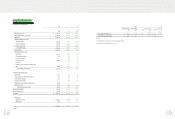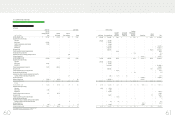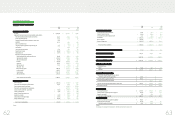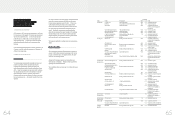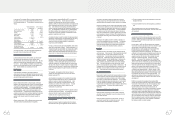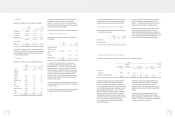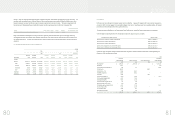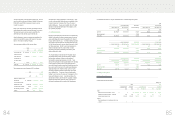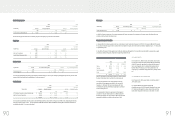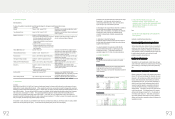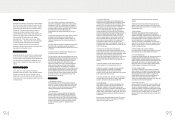HTC 2009 Annual Report Download - page 93
Download and view the complete annual report
Please find page 93 of the 2009 HTC annual report below. You can navigate through the pages in the report by either clicking on the pages listed below, or by using the keyword search tool below to find specific information within the annual report.
capital surplus amounting to NT$2,566 thousand (US$80 thousand).
As of December 31, 2009, the total capital surplus from long-term
equity-method investments was NT$18,411 thousand (US$576
thousand).
The additional paid-in capital from a merger was NT$25,756
thousand as of January 1, 2008. Then because of treasury stock
retirement in January and November 2009, the additional paid-in
capital from a merger decreased to NT$25,189 thousand (US$787
thousand) as of December 31, 2009.
Appropriation of Retained Earnings and Dividend Policy
Based on the Company Law of the ROC and the Company’s Articles of
Incorporation, 10% of the Company’s annual net income less any
deficit should first be appropriated as legal reserve. From the
remainder, there should be appropriations of not more than 3‰ as
remuneration to directors and supervisors and at least 5% as
bonuses to employees.
The appropriation of retained earnings should be proposed by the
board of directors and approved by the stockholders in their annual
meeting.
As part of a high-technology industry and a growing enterprise, the
Company considers its operating environment, industry
developments, and long-term interests of stockholders as well as its
programs to maintain operating efficiency and meet its capital
expenditure budget and financial goals in determining the stock or
cash dividends to be paid. The Company’s dividend policy
stipulates that at least 50% of total dividends may be distributed as
cash dividends.
Had the Company recognized the employees’ bonuses of
NT$1,313,200 thousand as expenses in 2007, the pro forma
earnings per share in 2007 would have decreased from NT$50.48 to
NT$48.19, which were not adjusted retroactively for the effect of
stock dividend distribution in the following year.
The bonus to employees of NT$6,164,889 thousand for 2008 were
approved in the stockholders’ meeting in June 2009. The bonus
to employees included a cash bonus of NT$1,210,000 thousand
and a share bonus of NT$4,954,889 thousand. The number of
shares of 13,357 thousand was determined by dividing the amount
of share bonus by the closing price (after considering the effect of
cash and stock dividends) of the shares of the day immediately
preceding the stockholders’ meeting. The approved amounts of
the bonus to employees were the same as the accrued amounts.
Based on a resolution passed by the Company’s board of directors
in February 2009, the employee bonus for 2009 should be
appropriated at 18% of net income before deducting employee
bonus expenses. If the actual amounts subsequently resolved by
the stockholders differ from the proposed amounts, the differences
are recorded in the year of stockholders’ resolution as a change in
accounting estimate. If bonus shares are resolved to be
distributed to employees, the number of shares is determined by
dividing the amount of bonus by the closing price (after
considering the effect of cash and stock dividends) of the shares of
the day immediately preceding the stockholders’ meeting.
As of January 18, 2010, the date of the accompanying
independent auditors’ report, the appropriation of the 2009
earnings had not been proposed by the Board of Directors.
Information on earnings appropriation can be accessed online
through the Market Observation Post System on the Web site.
22. TREASURY STOCK
On October 7, 2008, the Company’s board of directors passed a
resolution to buy back 10,000 thousand company shares from the
open market. The repurchase period was between October 8,
2008 and December 7, 2008, and the repurchase price ranged
from NT$400 to NT$500 per share. If the Company’s share price
was lower than this price range, the Company might continue to
buy back its shares. The Company bought back 10,000 thousand
shares for NT$3,410,277 thousand during the repurchase period
and retired them in January 2009.
)LQDQFLDO,QIRUPDWLRQ
Global Depositary Receipts
The Company issued 14,400 thousand common shares
corresponding to 3,600 thousand units of Global Depositary Receipts
(GDRs). For this GDR issuance, the Company’s stockholders,
including Via Technologies, Inc., also issued 12,878.4 thousand
common shares, corresponding to 3,219.6 thousand GDR units.
Thus, the entire offering consisted of 6,819.6 thousand GDR units.
Each GDR represents four common shares, with par value of
NT$131.1. For this common share issuance, net of related
expenses, NT$1,696,855 thousand was accounted for as capital
surplus. This share issuance for cash was completed and
registered on November 19, 2003.
The holders of these GDRs have the same rights and obligations as
the stockholders of the Company. However, the distribution of the
offering and sales of GDRs and the shares represented thereby in
certain jurisdictions may be restricted by law. In addition, the GDRs
offered and the shares represented are not transferable, except in
accordance with the restrictions described in the GDR offering
circular and related laws applied in Taiwan. Through the depositary
custodian in Taiwan, GDR holders are entitled to exercise these
rights:
a.To vote; and
b.To receive dividends and participate in new share issuance for cash
subscription.
Taking into account the effect of stock dividends, the GDRs increased
to 8,493 thousand units (33,971.9 thousand shares). The holders of
these GDRs requested the Company to redeem the GDRs to get the
Company’s common shares. As of December 31, 2009, there were
3,067.4 thousand units of GDRs redeemed, representing 12,270
thousand common shares, and the outstanding GDRs represented
21,702 thousand common shares or 2.75% of the Company’s
common shares.
Capital Surplus
Under the Company Law, capital surplus can only be used to offset a
deficit. However, the capital surplus from share
issued in excess of par (additional paid-in capital from issuance of
common shares, conversion of bonds and treasury stock
transactions) and donations may be capitalized, which however is
limited to a certain percentage of the Company’s paid-in capital.
Also, the capital surplus from long-term investments may not be
used for any purpose.
The additional paid-in capital was NT$4,374,244 thousand as of
January 1, 2008. In January and November 2009, the retirement
of treasury stock caused a decrease of additional paid-in capital
amounted to NT$57,907 thousand (US$1,810 thousand) and
NT$81,330 thousand (US$2,542 thousand), respectively. In
addition, the bonus to employees of NT$6,164,889 thousand for
2008 were approved in the stockholders’ meeting in June 2009.
Of the approved amount, NT$4,954,889 thousand, representing
13,357 thousand common shares which was determined by fair
value, would be distributed by common stock. The difference
between par value and fair value of NT$4,821,316 thousand
(US$150,713 thousand) was accounted for as additional paid-in
capital. As a result, the additional paid-in capital as of December
31, 2009 was NT$9,056,323 thousand (US$283,099 thousand).
Under the Company Law, the Company may transfer the capital
surplus to common stock if there is no accumulated deficit.
The capital surplus from long-term equity investments was
NT$15,845 thousand as of January 1, 2008. When the Company
did not subscribe for the new shares issued by Vitamin D Inc. in
September 2008, January 2009 and June 2009, adjustments of
NT$1,689 thousand, NT$187 thousand (US$6 thousand) and
NT$484 thousand (US$15 thousand) were made to the investment
carrying value and capital surplus, respectively. The Company
also determined that the recoverable amount of this investment
was less than its carrying amount and recognized an impairment
loss on its carrying value. As a result, the carrying value of this
investment became zero and the Company reversed a capital
surplus of NT$2,360 thousand (US$74 thousand) that was
recognized in prior years for the movement of Vitamin D’s capital
surplus in proportion to the Company’s equivalent stock. Also
recognized was the movement of other investees’
)LQDQFLDO,QIRUPDWLRQ


